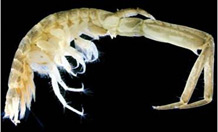
Crustaceans may be harmed by several stress factors
Rising ocean acidity makes the effects of pollutants more damaging
Increasing levels of carbon dioxide in our atmosphere are changing ocean chemistry, making seawater more acidic. New research shows that acidification of UK seas, caused by climate change, may make industrially polluted sediments more toxic over time, posing a potential threat to some sea life.
Crustaceans that feed on the surface of sediments from dredged ports and estuaries are at risk as increasingly acidic oceans cause these sediments, contaminated with metal, to become more toxic. Ingestion of these contaminated sediments has been found to result in significant DNA damage which could prove fatal for some crustaceans.
Researchers from the University of Exeter and the Centre for Environment, Fisheries and Aquaculture Science (Cefas) placed dredged material from an industrialised estuary into laboratory tanks and introduced burrowing crustaceans which normally graze on the sediment surface. They then exposed the creatures to seawater with levels of carbon dioxide found in seawater today, as well as more acidic future ocean conditions with carbon dioxide levels predicted for the next 50 and 100 years. Animals that survived ten days in these tanks were then tested to see if they incurred DNA damage.
The animals experienced significant DNA damage, which rose with acidification levels, suggesting that when acidification is combined with metal in sediments it can be more harmful.
However, the study also showed that as toxicity of ingested metals rises, animals are sometimes able to adapt their behaviour to cope.
Dr Ceri Lewis, from the University of Exeter explained: “There may be some variation in tolerance levels of acid water between species that might result in some being better able to cope with the effects of climate changes.”
Some commercially important crustaceans, like lobsters and scallops, now need to be assessed to see if they are also exposed to contaminated sediments.
At the moment dredged sediments are monitored and if toxicity falls below a predetermined threshold they are considered safe to deposit in the sea. However, rising ocean carbon dioxide levels may put more stress on the animals, on top of the metal toxicity, meaning current threshold values will need to be changed to make sure all marine animals, including crustaceans, are protected.
This is an edited version of a full article that first appeared on Planet Earth Online.
Date: 14 February 2013
